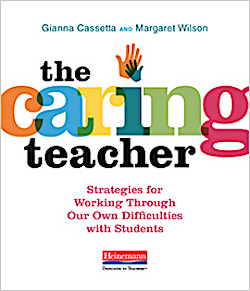How to Be Sure You Are a Caring Teacher
The Caring Teacher: Strategies for Working Through Our Own Difficulties with Students
By Gianna Cassetta and Margaret Wilson
(Heinemann, 2020 – Learn more)

“Too often we underestimate the power of a touch, a smile, a kind word, a listening ear, an honest compliment, or the smallest act of caring, all of which have the potential to turn a life around.” – Leo Buscaglia
Are you ready to commit to becoming a better teacher? Are you ready to examine your current teaching practices – not curriculum, but your presence, your delivery and your teaching “soul”?
Whether we’re new at the job or well along the teaching path, are we ready to examine, reflect, and make changes? Are we ready to meet one of the hardest challenges in any professional career – learning more about ourselves?
If the answers are “yes,” then The Caring Teacher: Strategies for Working Though Our Own Difficulties with Students by Gianna Cassetta and Margaret Wilson is a book that you must read, write in, respond to, tag with sticky notes and flags, and share with others.

You might even hear (or say to another teacher), “Enjoy your class this year because the one coming up is a doozy, especially so and so.” Or have you ever heard … “They just don’t care. I’m done with rewarding him/her for improper behavior. Let next year’s teacher deal with it.”
These remarks are not necessarily from teachers who are burned out, who have lost their zeal to make changes in the lives of their students. They are sometimes spoken by teachers who are great and caring educators but are having difficulty making connections with some of the students in their class and don’t see why.
This book can help caring but frustrated teachers overcome their difficulties and make those connections that will impact the lives of your current class and classes you haven’t met yet.
Authors who have walked the walk
Each of the scenarios in The Caring Teacher is drawn from the authors’ own experiences. They have walked those halls, made those comments, lost control. They acknowledge they’ve experienced defeat, remorse, and soul searching. They admit their own biases in the classroom.
Because they are honest and share their innermost thoughts, the scenarios they present are totally relatable. We’ve all had the child who “just wouldn’t do the work,” who didn’t seem to connect with the rest of the class, who clung to the “I can’t do it” security blanket no matter how often we got out the growth mindset guidebook.
The authors of The Caring Teacher work hard to gain credibility with us – their readers. And then they expect us to be equally open and honest about ourselves as we hear what they have to say to us.
Our unconscious bias
Unfortunately, we bring unconscious bias into our classroom whether we realize it or not. Saying “I don’t see color. I just see students” isn’t enough. Saying we don’t favor some students over others isn’t enough. It’s important for us to really examine how we work with and for our students. The authors suggest that we must “shift our paradigm about how children can and should fit into the structure of a classroom community.” (p. 13)
Statistics and research speak loudly:
• Black students are nearly four times more likely to be suspended and nearly twice as likely to be expelled as white students.
• Black children represent 18 percent of preschool enrollment, but make up 48 percent of preschool children who receive more than one out-of-school suspension.
• When teachers establish positive relationships with children, the kids do better socially and academically (e.g., Patrick et al. 2003; Roorda et al. 2011; Watson Battistich 2006)
(Source: Civil Rights Data Collection, USDOE, 2016)
It’s important for us to examine our teaching practices with a conscious mind to determine what our own biases are and how to overcome them.
Considering how you can embody caring
If I asked you to think about a favorite teacher, I don’t think you would tell me about their great lesson plans or his/her perfect handwriting, but you would give me an example of when you realized that teacher cared about you. Children have an innate ESP that signals when they feel teachers don’t genuinely care deeply about them. “Caring is the very bedrock of all successful education.” (Noddings 1992, 27)
When I began to read this book, I was reminded of when we used to play teacher as young children, mimicking what we heard or thought we heard in the classroom. Students want to emulate their teachers and often unconsciously follow their leads and mannerisms into relationships with other students in the classroom.
One author told a story about Juan who told his parents that he felt picked on by the teacher and she didn’t like him. Some of us might have bristled at the insinuation, but she took it to heart, realizing that the way Juan’s peers were treating him probably did mirror her actions in some way. The students were picking up her “vibes” through words, facial expressions, body language. So she set out to examine her unconscious biases.
As we read these stories shared by the authors, we have to be ready to “step back” and challenge ourselves and our own thinking – our preconceptions, our norms, our philosophy, our state of mind in the classroom. The process they recommend asks us to reexamine how and why we teach the way we do.
You are going to be asked to record your reflections, questions, and thoughts, and to think critically about what is happening during your classes. But every moment you spend on it is going to be worth it. When you succeed, you will have created a classroom where you will connect with students and be able to instill in them a commitment to learning.
Why I love this book
Although it is research based, the book is easy to read. It builds on your current practices, adding to what you are already doing well, giving you some hints and ideas on how to approach students in new ways. The shifts that are suggested – such as “Change How You Speak to Children” – are followed with strategies such as “Use a Genuine Tone” and “Address Actions, Not Character,” and a commitment to “Replace Problematic Language.”
I love this book because it causes us to think, to reflect about who we are and where we want to be heading as educators. The authors remind us of what Rita Pierson said in her 2013 TED Talk, “Every child needs a champion.” We can be that champion for our students – the person who cares about them, no matter.
I strongly recommend The Caring Teacher for all of us who’ve chosen to make our lives meaningful by spending our time in classrooms – for beginning teachers to use as a journal to follow their teaching year, for veteran teachers who are questioning whether they continue to make a difference, and for teachers who want to be sure they always do.
After teaching fourth and fifth graders for many years, Linda Biondi is supervising preservice and student teachers at The College of New Jersey and Rider University. Last summer she co-facilitated a week-long writing institute in conjunction with the National Writing Project at Rider University. She volunteers for two service organizations: Homefront and Dress for Success of Central New Jersey – both have a mission to end poverty and homelessness. The mission of Dress for Success is to empower women to achieve through economic independence.






























